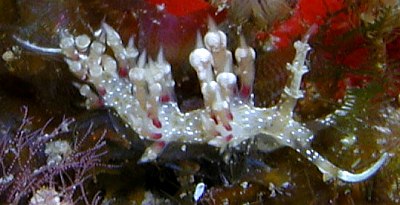
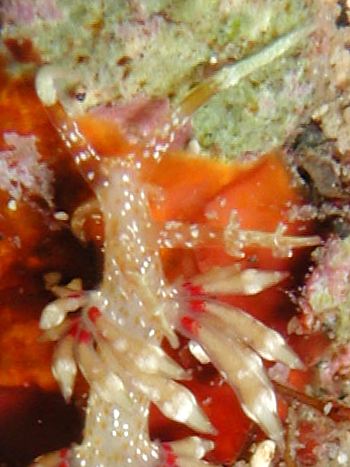
Cratena cf. affinis
Order: NUDIBRANCHIA
Suborder: AEOLIDINA
Family: Glaucidae
PHOTO
Hachijo Island, Japan. Upper: 27 Oct. 2002, Length: 4mm, Depth: 8m. Lower: showing head and anterior end - 8 June. 2002, Length: 8mm, Depth: 8m. Photos: Nishina Masayoshi
Very similar in general shape to Cratena affinis but has some significant consistent differences in external shape and colour. In particular it lacks white lines on the cerata and lacks a red patches on each side of the head. It also seems that the flattened rings found on the rhinophores of C. affinis are replaced here by a radiating set of papillae. See messages on this page and the C. affinis page for more detailed discussion on the similarities and differences.
Authorship detailsRudman, W.B., 2002 (December 2) Cratena cf. affinis [In] Sea Slug Forum. Australian Museum, Sydney. Available from http://www.seaslugforum.net/find/cratcfaffi
Related messages
Cratena affinis? from South Africa
October 26, 2006
From: Colin Ogden
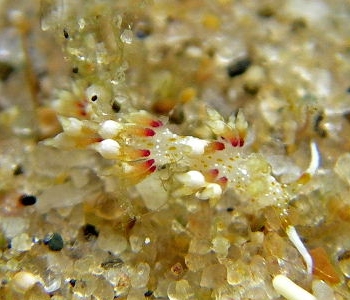
Hi Bill,
Jesse Veldmann found this creature in our rock pools. I think it looks like the forum's Cratena cf affinis, but that one seems to exist only in Japan. I know we try to define the areas these tiny creatures live, but they always have a surprise for us. Your comments would really be appreciated.
Locality: Sodwana Bay, 0 metres, South Africa, Indian, July 2006, Rock pool. Length: 8 mm. Photographer: Jesse Veldmann.
Our list of Nudibranchs here has now reached 229 species ( in 2 years) and our record for the most number of different species observed and photographed in 1 dive is now 28 different species. Sorry about that probably irrelevant info, but I thought it might just be of interest.
Regards
Colin
scubaco@iafrica.com
Ogden C. M., 2006 (Oct 26) Cratena affinis? from South Africa. [Message in] Sea Slug Forum. Australian Museum, Sydney. Available from http://www.seaslugforum.net/find/17673Dear Colin,
Your comments are certainly not irrelevant. I suspect it will be a number of years - hopefully never - before you reach the stage where nothing surprises you.
I am pretty sure this is the animal Terry Gosliner has in his book, Nudibranchs of Southern Africa, as Cratena sp. 3 [sp 263: p127]. I am not sure if this is the same as the Forum's Cratena cf affinis and would need to know something about the shape of the rhinophores and the front of the foot before I could say anything else.
Best wishes,
Bill Rudman
Rhinophore shape of Cratena cf. affinis
December 17, 2002
From: Nishina Masayoshi
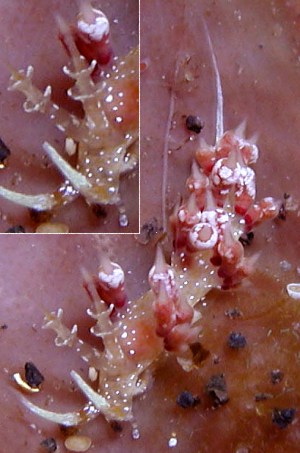
Dear Bill,
To accompany my other photos, here are photos of the close-up of the rhinophores. I agree with your opinion that "the 'rings' on the rhinophores seem to be a series of radiating papillae rather than a solid plate. However the don't seem so clear in some of the other photos,"
The rhinophores rings in these photos are rather wavy. I suspect that the radiating papillae shaped 'rings' are because of some damage or on the way of regrow? or just a variation? This animal often found on the reddish coral. So I suspect it's the their diet.
All photos by M. Nishina on Hachijo Island.
Date: 7 Dec, 2002. Size: 6mm-8mm
Best Regards,
Nishina Masayoshi
nishina@wips.co.jp
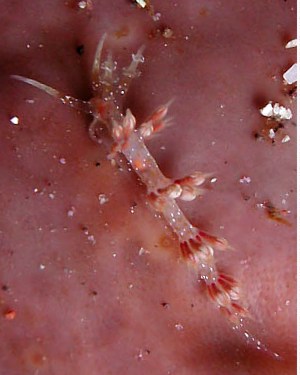
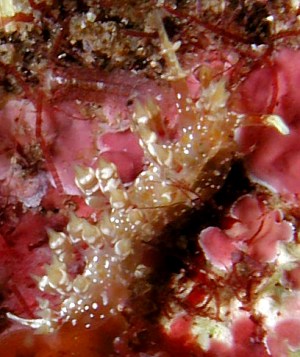
Thanks Nishina,
The structure of the rhinophore plates is a bit difficult to determine from the photos but does seem to be quite variable. In the top photo there seems to be a posterior notch or break in the plate, while in the lower left photo there seems to be a very wavy edge as you describe. Concerning its food. I would be surprised if it was eating the coral, but it is possible that there is a hydroid that is growing in association with the coral and appears as single red polyps, on a short stalk, scattered over the coral colony.
Best wishes,
Bill Rudman
Re: Cratena cf. affinis from Japan
December 4, 2002
From: Nishina Masayoshi

Dear Bill,
As requested, here are some more photos of Cratena affinis - Type C [see earlier message]. I photographed them all at Hachijo Island. None of them were moved from their natural habitat for the photo.
Upper Right: 27 Oct. 2002, Length: 4mm, Depth: 8m
Lower Left: 1 Dec. 2001, Length: 8mm, Depth: 6m
Lower Right: 8 June. 2002, Length: 8mm, Depth: 8m
I am a bit hesitant about the lengths, as they are very thin and small for me to photograph. I suspect these animals and the animal from R. Nakano (and maybe S. Hayashi's too) on your Forum which was sorted as Cratena affinis are probably the same.
Best Regards,
Nishina Masayoshi
nishina@wips.co.jp
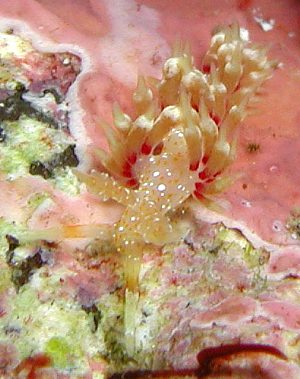
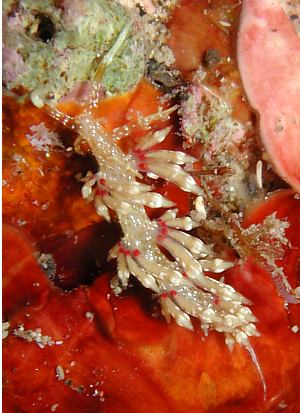

Thanks Nishina,
These photos are a useful addition and the closeup alongside clearly shows the radiating papillae which form the rhinophore 'rings'. However the don't seem so clear in some of the other photos, so it will be worth checking the nature of the rhinophore rings in other specimens of this colour 'form'. I think I'll keep this 'form' or 'species' separate from more 'typical' C. affinis on the Forum. I agree with your suggestion that R. Nakano's and S. Hayashi's photos belong there as well.
Best wishes,
Bill Rudman
Cratena affinis from The Japan Sea
July 27, 2002
From: Shigeru Hayashi
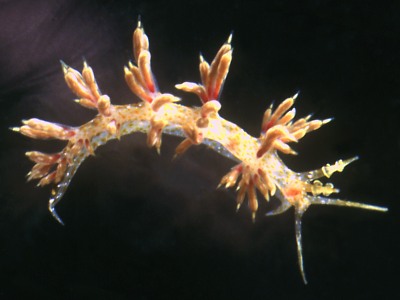
Dear Bill,
Here is a photo of Cratena affinis to help give us a fuller idea of its variation. C. affinis lives in the same environment as C. lineata but is not often found.
Collection data: 13 August 2000. Sado Island. 15mm length.
Yours Sincerely
Shigeru Hayashi
(Takaoka Biological Club)
jr9dsx@tko.fitweb.or.jp
Hayashi, S., 2002 (Jul 27) Cratena affinis from The Japan Sea. [Message in] Sea Slug Forum. Australian Museum, Sydney. Available from http://www.seaslugforum.net/find/7563Thanks Shigeru,
In Baba's (1949) painting the digestive gland duct is dark brown, almost black, and there are fine white longitudinal lines down the cerata. It would seem that this is one of those species in which the colour of the ceratal digestive gland is determined either by what the animal has just eaten, or whether it has recently eaten.
Bill Rudman
Cratena affinis from Hachijo Is., Japan
July 13, 2002
From: Rie Nakano
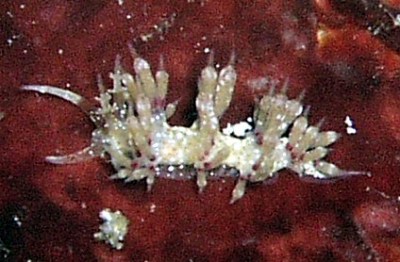
Dear Dr.Rudman,
I found this Cratena at the edge of the rocky reef of Hachijo Island, Izu, Japan, in 28th, September, 2001.
Is this Cratena affinis
Depth:15m
Length:30mm
Water temperature:24.6 degrees
Frequency:uncommon in Hachijo
Sincerely,
Rie Nakano
rie@divers.ne.jp
Nakano, R., 2002 (Jul 13) Cratena affinis from Hachijo Is., Japan. [Message in] Sea Slug Forum. Australian Museum, Sydney. Available from http://www.seaslugforum.net/find/5502Dear Rie,
I am sure you are right. Although the colours are rather different from the painting in Baba (1949) this fits in all major respects Baba's Hervia affinis. In particular the two large flattened rings on the rhinophores are very distinctive, and so are the inflated cerata which abruptedly end in a thin tapering papilla at the tip. Baba notes the body is covered in white spots, as is your animal, and describes the cerata as having fine, longitudinal, opaque white lines and a dark digestive gland. In your animal only traces of those lines are present and I presume the colour of the digestive gland duct is dependent on the slugs recent diet. I can't check in this photo for the presence or absence of the two orange red patches on the head, that Baba describes. On balance I would agree that this is Cratena affinis. The most appropriate genus for this species must wait until more material is examined.
Best wishes,
Bill Rudman.
